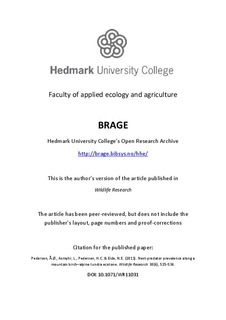Nest-predator prevalence along a mountain birch–alpine tundra ecotone
Journal article, Peer reviewed

Åpne
Permanent lenke
http://hdl.handle.net/11250/134412Utgivelsesdato
2011Metadata
Vis full innførselSamlinger
Originalversjon
Pedersen, Å.Ø., Asmyhr, L., Pedersen, H.C. & Eide, N.E. (2011). Nest-predator prevalence along a mountain birch–alpine tundra ecotone. Wildlife Research 38(6), 525-536. 10.1071/WR11031Sammendrag
Context. Nest predation is a major factor influencing life history and population dynamics of ground-nesting birds. The transitions between the northern boreal mountain birch forests and the low-alpine tundra are important habitats for the willow ptarmigan, Lagopus lagopus (Linnaeus, 1758). During the past decades, these landscapes have been extensively developed with cabin resorts in southern Norway, which has led to an increased number of roads and foot paths in relatively undisturbed habitats.
Aims. The aim of the present study was to investigate relative nest-predation rates in elevation gradients (ecotones) spanning from northern boreal mountain birch forests to low-alpine tundra in three locations with contrasting willow ptarmigan densities.
Methods. We conducted an artificial nest study by using baited track boards (n = 108). Track boards were placed along transects (200 m) in the following three habitat types: birch forest, edge habitat and low-alpine tundra. Predator prevalence was analysed in relation to study-design variables (location, habitat, study period) and the load of human infrastructure (i.e. distance to foot paths and roads), using generalised linear mixed-effect models assuming binomial distribution for the response variable.
Key results. Prevalence of avian predators was consistently high (range 38.2–85.3%), in contrast to much lower prevalence of mammalian predators (range 2.8–22.9%). Raven (Corvus corax) was the dominant nest predator, followed by hooded crow (C. cornix) and pine marten (Martes martes). Location, as contrasted by differences in willow ptarmigan density, was not significantly related to total relative predation rates. Species-specific predator prevalence was habitat specific and related to human infrastructure, but with opposite relative predation patterns between pine marten and raven. Hooded crow predation was similar across the ecotone and not related to human infrastructure.
Conclusions. Predator prevalence was habitat specific and affected by human infrastructure (distance to human foot paths). Our study confirmed that human activity might alter the predation rates by generalist species in these low-alpine environments.
Implications. We recommend that attractive willow ptarmigan habitat should be avoided when planning human infrastructure in alpine ecosystems. To reduce predation pressure in this ecosystem, it appears that generalist predators should be considered for management actions. Further research is needed to explain the underlying mechanism driving expansion of generalist species into alpine habitats. Such knowledge is also important in developing alternative management actions with focus other than predator control.
Beskrivelse
Dette er postprint versjonen av en artikkel publisert i Wildlife Research. Den publiserte versjonen av artikkelen kan finnes her: http://www.publish.csiro.au/paper/WR11031